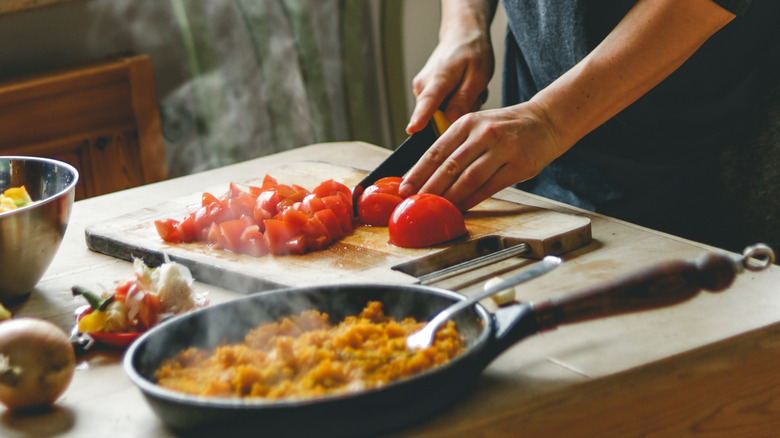Secrets from the Italian Kitchen: Lessons from Nonna
Hey chefs,
After a week of simmering sauces and twirling pasta in culinary school, I’ve realized something: no matter how precise our measurements or refined our techniques, Italian cooking always comes down to soul. You can taste when a sauce was made by someone who cooks with patience and heart — and Italians have been perfecting that balance for centuries.
Here are a few timeless Italian grandma tips that culinary school can teach you, but only practice (and love) can perfect.
1. Taste, don’t measure.
Italian cooks rarely cook by exact measurements. In class, we learn ratios and precision, but in Italy, you learn intuition. Salt a pinch at a time, drizzle olive oil until it looks right, and always taste as you go. The best Italian food is balanced by instinct.
Tip: When seasoning sauces, remember the “rule of the spoon.” If your spoon comes out coated, your sauce has the right texture. If it runs off like water, let it simmer longer.
2. Salt your pasta water like the sea.
It’s one of the first lessons every culinary student hears, but Italians have lived by it for generations. The pasta water should taste almost like seawater — this ensures the pasta itself is seasoned before it ever meets the sauce.
Tip: Save a ladle of that starchy pasta water before you drain it — it’s liquid gold for creating a smooth, glossy sauce that clings perfectly.
3. Respect the soffritto.
Italian grandmothers know that everything good begins with soffritto — finely diced onion, carrot, and celery cooked slowly in olive oil. It’s not just a base; it’s the foundation of flavor. In culinary school, we call this “building layers.” In Nonna’s kitchen, it’s just “the right way to start.”
Tip: Cook soffritto low and slow — it should soften and sweeten without browning. If you hear sizzling, your heat is too high.
4. Simmer, don’t rush.
Whether it’s a Sunday ragù or a pot of soup, Italians know good things take time. Culinary school teaches efficiency; Italian grandmothers teach patience. Bolognese isn’t ready when the clock says so — it’s ready when it tastes like it’s been kissed by time.
Tip: Keep your sauce at the barest simmer. If it’s bubbling like a witch’s cauldron, it’s boiling away its depth.
5. Always finish pasta in the sauce.
This is one of those techniques that separates restaurant-quality pasta from everything else. Don’t just pour sauce on pasta — finish cooking the pasta in the sauce for the last minute or two. The starches bind everything together, giving that velvety restaurant finish.
Tip: Add a splash of pasta water while tossing. The starch emulsifies with the sauce for a perfect, glossy coating.
6. Use the right pasta for the right sauce.
Nonna would never serve spaghetti with Bolognese — and neither should you. Each pasta shape has a purpose:
- Smooth sauces (like pomodoro) love thin strands like spaghetti or capellini.
- Chunky ragùs belong on wide noodles like tagliatelle or pappardelle.
- Creamy sauces cling beautifully to ridged shapes like rigatoni.
Tip: Think of it like pairing wine and food — texture meets texture, richness meets balance.
7. Olive oil is an ingredient, not just a lubricant.
To Italians, olive oil isn’t something you “add at the end” — it’s a flavor in itself. Always use good-quality extra virgin olive oil, and know when to cook with it versus when to finish with it.
Tip: For cooking, use mild olive oil so it doesn’t burn. For finishing, drizzle a peppery, fruity oil right before serving to wake up the dish.
8. Parmesan isn’t just garnish — it’s seasoning.
Grated Parmigiano-Reggiano adds salt, umami, and body. Sprinkle it into sauces to enrich the flavor, not just on top for looks. Italians use it the way others use salt — to deepen the taste of everything it touches.
Tip: Avoid pre-grated cheese. The anti-caking agents change the way it melts and can dull the flavor.
9. Cook with your ears.
This one might be my favorite. Nonna doesn’t need a thermometer — she listens. When olive oil starts to whisper, it’s ready for garlic. When the sauce begins to murmur softly, it’s simmering just right. Trust your senses more than your timer.
10. Food tastes better when it’s shared.
This may sound cliché, but it’s culinary truth. Italian cooking is about feeding people — not impressing them. The love you put into stirring, tasting, and serving matters more than any garnish ever will.
Tip: Taste your sauce with someone else before serving. If they smile, you’re done.
Mastering the Italian classics is about more than recipes — it’s about rhythm, instinct, and heart. In culinary school, we learn the science of cooking; from Italian grandmothers, we learn the feel of it. And when you can blend both, that’s when magic really happens.
Until next time — live, laugh, ladle.
 Brennah Van Wagoner
Brennah Van Wagoner
Weekly Newsletter Contributor since 2025
Email the author! brennah.oaks@gmail.com

